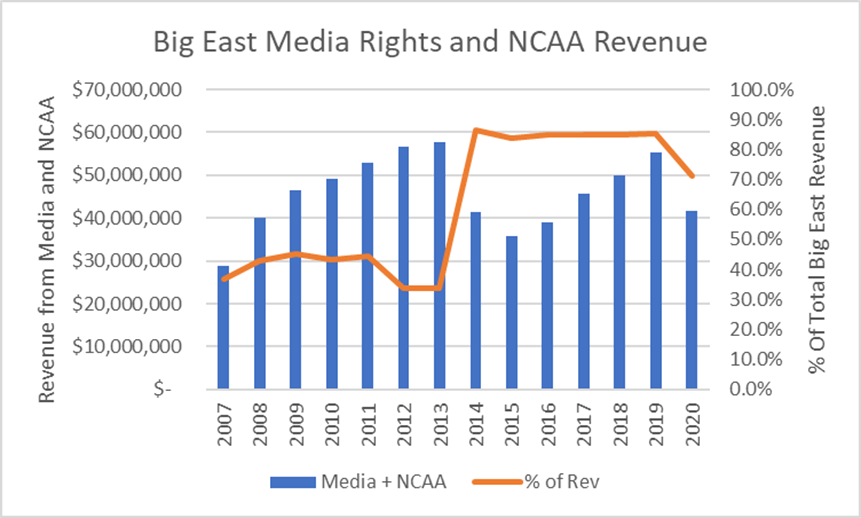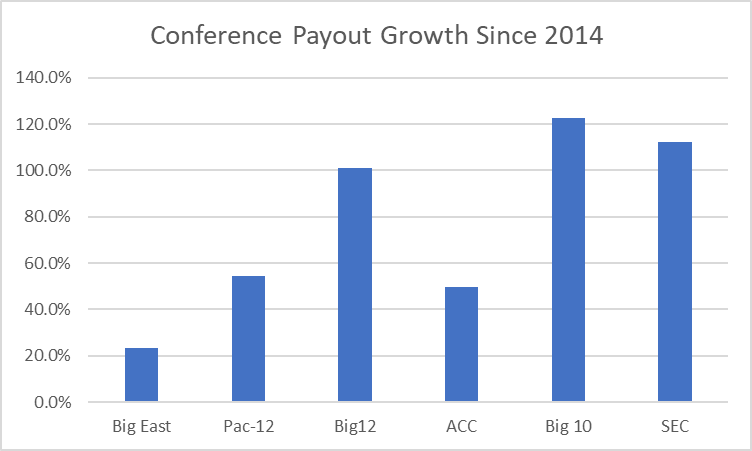Editor’s Note: I’m not a tax expert, but as some Sports Information Directors will gladly point out, I did stay at a Holiday Inn Express once. So just wanted to put this right up front, take all of this “analysis” with as much salt as necessary to remind yourself that I’m just a schlub reading tax documents.
But, and it’s an important but, those tax documents are the only filters of light we see into the black boxes known as NCAA conferences. And I think I’m in the 0.1% of nerds who have actually gone digging, so as inadequate as my credentials and expertise are, it beats a lot of what you might read on Twitter and the web.
With the deluge of articles and thinkpieces coming out once UCLA and USC bailed on the Pac-12 for the Big Ten, it got me curious to better understand the financial landscape of college conferences, and because this is a Marquette blog, specifically for the Big East.
In the past, I’ve relied on news articles and conference releases to aggregate data, but after a few lucky clicks, found that most of the answers are publicly available in IRS 990 Form tax filings all conferences must submit on a yearly basis.
And seeing as I’m just a journalism major with a limited understanding of finances and taxes, I wanted to explain it to someone at my level?
How Does the Big East Make Money?

For the most part, the Big East makes money by selling the television rights to the basketball games its members partake in at home games or during conference play. Since the reformation, the Big East has seen about 66% of its listed revenue come via TV and Radio rights, with almost all of that coming from FOX’s TV deal for an average of $33.4M a year.
This is why I’m so heavily invested in TV ratings and have been since before the new Big East tipped off. Without getting ahead of upcoming segments, the Big East’s media deal was an overpay by FOX and has allowed the conference to maintain financial contact with the P5 the past 8 years. With the contract running through 2025, just as SEC and Big Ten revenues really explode, we should be hearing about potential extensions/negotiations in the next year or so. No big deal, just the fate of the conference at play.
Anyway, the rest of the conference’s revenue mostly falls in the following 3 buckets:
NCAA Revenue: Primarily (if not wholly) NCAA Tournament Shares from the past 6 years
Corporate Sponsors: Think Jeep or Abercrombie
Conference Championships: Primarily the Big East Tournament
The 2020 season is a great case study into just how important the Big East Tournament is to the conference. With it being cancelled in the early stages due to COVID, the conference lost out on at least $7 million in projected revenue. Having looked into 990s for the top 10 basketball conferences, no tournament does as well or means so much to the bottom line.
The 2020 NCAA payout numbers are also lower than in 2019 due the COVID altered season, where there was no NCAA Tournament held. Instead of distributing its $600M+ like in 2019, the NCAA only distributed $269M, more than halving usual payments to schools and conferences.
All of this is to say, when it comes to the health of the Big East, the FS1 deal and NCAA Tournament shares make up about 87% of revenue in an average year.

It isn’t like this for the other “P6” conferences. In 2019, the last full normal season we have records for, only the ACC was above 75% for total revenue coming from Media + NCAA (76.6%). The Big 10 was around 64% that year as well and we are talking about much larger totals.
If we dig back to the pre-reformation days of the Big East, you can easily see how this changed starkly in 2014 as football revenues left or were left behind.

All of this just reinforces the fact that the Big East is extremely reliant on media rights and NCAA wins, moreso than P6 peers and even compared to earlier days. I am going to continue to drill this message for the next 3 or 4 articles.
What Does the Big East Spend On?

Obviously there are plenty of categories we didn’t include, but for our purposes this encompasses about 85% of the conference’s expenses in a given year.
Commish: This is commissioner Val Ackerman’s total payments for the year
Production: This one was a bit difficult to decipher as they were direct payments to a Wisconsin company called Rush Media, but it turns out they do the behind the scenes production for the Big East Digital Network (aka as the non-basketball sports)
MSG: While not confirmed, I think this falls under “Tournaments” but I wanted to highlight just how expensive it was for the Big East to rent out the Garden for the BET (as well as media day). 2015 was the first year MSG was broken out as an independent contractor, so we don’t have a good feel for what it cost pre reformation. I also tried to see what it cost the Big Ten to put their conference tourney there a few years back but they did not list out the cost separately.
Tournaments: Exactly what it sounds like, what it costs the Big East to put on al of its conference tournaments.
Officiating: Again, easy to decipher. Per sources, the jump from 2015 to 2016 was an accounting change rather than an actual 670% increase in costs.
Payouts: The amount a conference sends to individual schools to help support athletic departments and activities. All the other categories are interesting, but this is where the focus will be going forward.
This is what it’s all about. When you read about the SEC and Big Ten lapping all conferences and preparing for a launch into another financial orbit, this is where it matters. Every conference takes a majority the pooled revenue and distributes it back to individual schools based on predetermined formulas.
For the Big East, just under 70% of all revenue collected is returned to the (now) 11 schools which has turned out to be an average of $3.7 Million per team per year. In 2020, that was up to $4.66M per team despite lower revenues in an effort to help stabilize budgets mid pandemic.
Now $4.66 million is not a small sum, but when compared to current P5 payouts, averaging between $30M and $45M and projected to nearly double for some conferences, you can see where concerns start to come in.

But obviously this includes football revenue so isn’t remotely apples to apples, and that’s for a different article, so let’s stick to the “known knowns” rather than the might happens.
And what we do know is that Big East payouts grown more slowly than the P6 peers.

One more note on payouts, they make up 69% of total expenses for the Big East while only 1 of the other 5 conferences is under 90% (the Pac-12 at 71.8%). That’s the other downside of working with much smaller overall numbers, your expenses even if equal in dollar terms make up a much larger percentage. So paying Val $1.8 million is right and justified by performance, but no other P6 commissioner came close to absorbing such a big portion (3% in 2020). The Big Ten equivalent would be paying Kevin Warren $21 million rather than the $4.1 million Kevin Warren is getting.
Conclusion
The Big East is very reliant on Media revenue and NCAA Tournament revenue. The Media revenue was relatively constant (up about 3.7% a year) in our lookback through 2020, but should see a bit of an update after adding UConn to the conference for the 2021 season. The NCAA Tournament revenue is dependent on performance (hence the need for Big East solidarity in March) but a quick estimate of units from 2017 to 2022 places that to be around $16 million from the NCAA just from tournament performance for next season.

However, 2019’s miserable performance (only 5 units), lack of a tournament in 2020 and mediocre 2021 (7 units) means the total NCAA payouts will be lower in the next few years than they have been in the near past, so there won’t necessarily be a huge surge from here.
The other big takeaway is how vital the Big East Tournament is, as the conference’s 3rd largest revenue source. And how that’s not necessarily a positive in the big picture, with revenue only seeing moderate increases from year to year, matched by increases in tournament expenses, like MSG.
Put this all together and we get a financial picture of a conference that isn’t going to see any huge revenue surges any time soon, and will have to keep expenses flat to maintain its payout levels growing. It’s still head and shoulders above any of the non-football conferences and will be an asset for programs going forward, but the relative levels won’t change.
It’s in good shape for now, but how is it set up going forward? Stay tuned.

Trackbacks/Pingbacks
[…] Big East signed a 12-year deal with FOX in 2012, which averages roughly $42 million annually ($3.8 million per school). That’s not a lot of money for a conference that prides itself on men’s basketball. To compare, […]